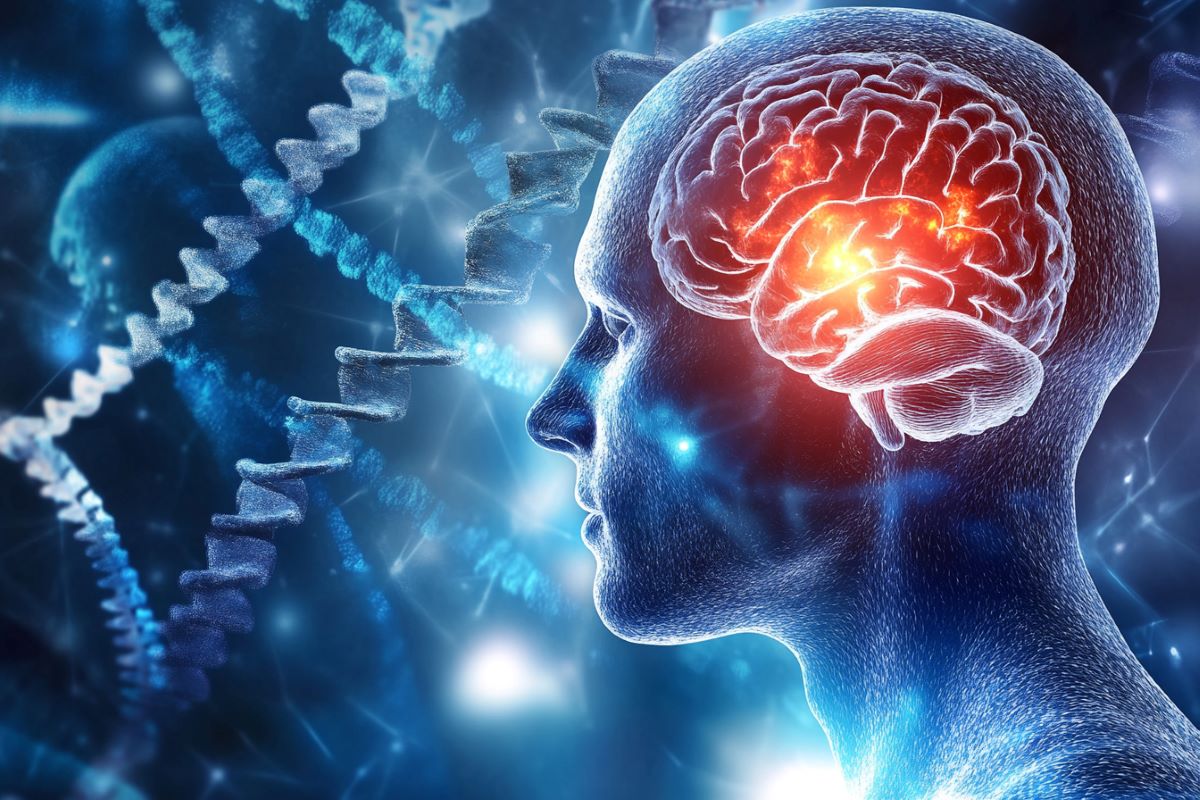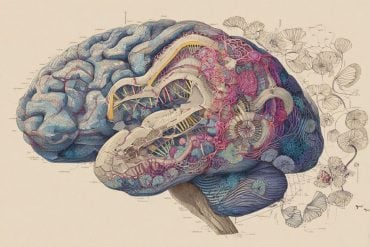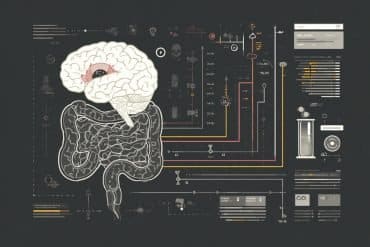Summary: Researchers identified a rare genetic mutation in two schizophrenia patients that increased schizophrenia-related behaviors in mice. The mutation led to higher levels of glycine decarboxylase (GLDC), an enzyme that degrades glycine, reducing NMDA receptor activation.
Mice with extra copies of the GLDC gene exhibited schizophrenia-like behaviors, confirming its role in the condition. Advanced brain analysis showed that available glycine was significantly lower in a specific brain region, disrupting neural signaling.
Key Facts:
- Genetic Link: Extra copies of the GLDC gene led to schizophrenia-like behaviors in mice.
- Brain Disruption: The mutation lowered glycine availability in a key brain region, impairing NMDA receptor function.
- Neural Impact: Reduced synaptic activity and impaired learning-related brain functions were observed.
Source: University of Illinois
A genetic mutation found in two human patients with schizophrenia also increased schizophrenia-related behaviors in mice with the same mutation, a rare finding of a direct genetic link to psychosis, report researchers at the University of Illinois Urbana-Champaign and colleagues in Massachusetts and Germany.
The mutation increases levels of glycine decarboxylase, or GLDC, an enzyme responsible for regulating glycine in the brain. Glycine activates receptors for the neurotransmitter glutamate, called NDMA receptors.

“The genetics of schizophrenia is very complex, and it is rare that mutations found in patients can be linked directly to the disease,” said study leader Uwe Rudolph, a professor of comparative biosciences at Illinois.
“Schizophrenia is not yet diagnosed by any kind of lab test or imaging; it’s still a clinical diagnosis based on symptoms. The hope is that these kinds of rare mutations could lead us to the biochemical and physiological pathways that are important to study.”
The study began when a genetic mutation was found in two patients with schizophrenia at McLean Hospital in Belmont, Mass. They had multiple copies of a section of DNA that included the gene for GLDC. Curious as to whether the mutation contributed to their symptoms, the McLean team studying the patients reached out to Rudolph’s lab to create a line of mice with the same mutation.
The mice with mutations analogous to those in the human patients also showed schizophrenia-associated behaviors.
To further narrow down the genetic link, the researchers next developed lines of mice with multiple copies of only a few genes contained within the larger chromosome segment repeated in the patients, then a single gene: GLDC.
“We found that extra copies of the GLDC gene alone were sufficient to render the schizophrenia-like behaviors we had observed,” said Rudolph, who also is affiliated with the Neuroscience Program and the Carl R. Woese Institute for Genomic Biology at Illinois.
To understand why multiple copies of the GLDC gene would be solely responsible for the behavioral symptoms, the researchers took a closer look at what was happening in the brains of the mice, specifically to the levels of glycine and the function of NDMA receptors.
“We hypothesized that extra copies of GLDC would result in a lower level of glycine in the brain, since it degrades glycine. Then there would not be enough glycine to help activate the NDMA receptors,” said Illinois postdoctoral researcher Maltesh Kambali, the first author of the paper.
“We measured an increase in activity of the GLDC enzyme in the brains of our mice, which would point to that as well.”
However, when the researchers measured glycine levels in the brains of their mice, there did not seem to be a significant difference between those with the extra GLDC and healthy mice. So Rudolph’s team turned to colleagues in Germany who had developed sophisticated methods of tracking glycine in the brain.
The German team found that, while the overall amount of glycine in the whole brain was similar, the amount of glycine outside of the nerve cells and available to help activate NDMA receptors was significantly lower in a subregion of the hippocampus in the mice with multiple copies of GLDC.
To see why this region of the brain was so affected, Rudolph’s team then worked with researchers at Harvard Medical School to perform functional studies on the affected brain subregion, called the dentate gyrus.
They identified decreased activity in the neural synapses, the active junctions that send signals between neurons. They pinpointed differences in long-term potentiation, a sustained strengthening of activity in the synapse during the learning process.
“We saw how glycine measurements and the long-term potentiation measurements were showing converging changes in this dentate gyrus region, but not in other regions of the hippocampus. It’s interesting because one theory links the development of psychosis to the activity in the dentate gyrus. So our findings fit with that theory,” Kambali said.
The Illinois team then conducted a biochemical analysis of the dentate gyrus in the mice with extra copies of GLDC. They found that some pathways previously implicated in schizophrenia had reduce activity, indicating that the increase of GLDC and associated decrease of glycine was indeed sufficient to inhibit the NMDA receptors’ function and was involved in the schizophrenia symptoms they had observed.
The researchers published their findings in the journal Molecular Psychiatry.
“This study demonstrated at multiple levels how GLDC functions as a novel regulator of NMDA receptors,” Rudolph said.
“Dysfunction of NMDA receptors has been shown to be important in the pathophysiology of schizophrenia. Yet this finding also is relevant independently of disease, as the NMDA receptor is essential for many brain functions, including learning and memory.”
This work was supported by the National Institutes of Health, the Shervert Frazier Research Institute at McLean Hospital, the Stanley Center for Psychiatric Research at the Broad Institute of Harvard and MIT, and a Harvard Brain Science Initiative Bipolar Disorder Seed Grant.
Funding:
This work was supported by the National Institutes of Health grants R21MH104505, R56MH112642, R01MH115957, R01HD096326, R01MH123155, R01NS093200, P50MH115874, R01MH123993, R01MH108665, R01MH051290, P50MH094271 and U01AA020889.
About this schizophrenia and genetics research news
Author: Liz Ahlberg Touchstone
Source: University of Illinois
Contact: Liz Ahlberg Touchstone – University of Illinois
Image: The image is credited to Neuroscience News
Original Research: Closed access.
“An increased copy number of glycine decarboxylase (GLDC) associated with psychosis reduces extracellular glycine and impairs NMDA receptor function” by Uwe Rudolph et al. Molecular Psychiatry
Abstract
An increased copy number of glycine decarboxylase (GLDC) associated with psychosis reduces extracellular glycine and impairs NMDA receptor function
Glycine is an obligatory co-agonist at excitatory NMDA receptors in the brain, especially in the dentate gyrus, which has been postulated to be crucial for the development of psychotic associations and memories with psychotic content.
Drugs modulating glycine levels are in clinical development for improving cognition in schizophrenia. However, the functional relevance of the regulation of glycine metabolism by endogenous enzymes is unclear.
Using a chromosome-engineered allelic series in mice, we report that a triplication of the gene encoding the glycine-catabolizing enzyme glycine decarboxylase (GLDC) – as found on a small supernumerary marker chromosome in patients with psychosis – reduces extracellular glycine levels as determined by optical fluorescence resonance energy transfer (FRET) in dentate gyrus (DG) and suppresses long-term potentiation (LTP) in mPP-DG synapses but not in CA3-CA1 synapses, reduces the activity of biochemical pathways implicated in schizophrenia and mitochondrial bioenergetics, and displays deficits in schizophrenia-like behaviors which are in part known to be dependent on the activity of the dentate gyrus, e.g., prepulse inhibition, startle habituation, latent inhibition, working memory, sociability and social preference.
Our results demonstrate that Gldc negatively regulates long-term synaptic plasticity in the dentate gyrus in mice, suggesting that an increase in GLDC copy number possibly contributes to the development of psychosis in humans.






